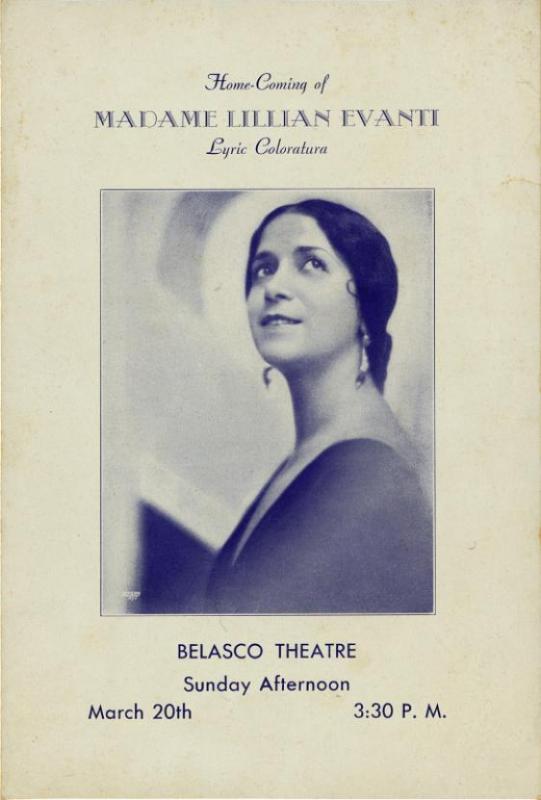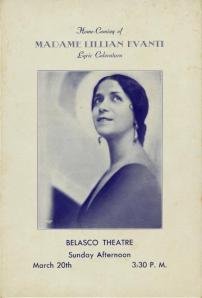
These days of instant ‘access’, where information remains available for placing and plucking in the ‘cloud’, and history can be found in motion at You Tube, museums, to my mind, seem often to be overstepped, and their place as primary sources that can offer more visceral ‘context’ to an investigation of history or excavation of information, are second thoughts for the average Indiana Jones.. …but there remains something almost mystical in the act of walking into an edifice that contains exhibitions of the past, where you know that artifacts and tangible effects of crucial detail and consequence lay in subbasements, in temperature controlled environments, sequenced, dormant.. For me, being able to ‘touch’ the past, to have it in its original ‘state’, tangible in the same space where I am, is an opportunity to revel in imagination of a previous moment in time; this is the excitement that I have connected to, in my exploration of the soprano Madame Lillian Evanti.
Madame Lillian Evanti
..she was a native Washingtonian, born, Annie Wilson Lillian Evans; in the first phase of her professional life, Miss Evans taught kindergarten in DC Public Schools; subsequently, in the heart of her passion as a singer, married, she took the stage name of Evanti (a conflation of her maiden name, and the initial letters of her husband’s –“Tibbs”) creating the European flare of her moniker; having studied music and dedicating herself to the bright flame of her voice, Madame Evanti left American, and conquered Europe with a premiere in Delibes’ opera Lakme, in Nice, France, in 1925. All this information is readily available online; what is not, is the full portrait of this woman, whose character, drive, network, self-promotion and artistic acumen, made her a true African American pioneer -in a music art form that most of America, at the time, considered (at the most ‘generous’ end of the spectrum) incompatible for negroes. Wishing to discern the nuances of temperament, and the details of thought that sculpted her life’s journey, I reached out to the Anacostia Smithsonian Museum who are the curators of Madame Evanti's papers and artifacts, to be found in the Evans-Tibbs collection. Jennifer Morris is the archivist and she facilitated my visit, maneuvering us down tight back hallways, and through a maze of stored exhibition furniture.. up, past corridors lined with offices, and across stairwells with large picture windows that looked out into the winter meadow surrounds of the museum.. and ultimately leading to a short hall at the end of which was the Archive Reading Room. The rectangular space was chilled and bright; a long wood table with chairs took up the majority of the space. On a steel gurney, ready for perusal, were three cartons of material from the collection.. I arrived at 10AM; I left that room at 12:45PM, having not looked at the clock once, far too astonished and aware of the items passing through my hands.. There were many nuggets of discovery waiting for me in these cartons; one in particular widened my eyes: in a nondescript manila folder, marked “Correspondence”, I came upon a small, short letter, on personalized light grey/blue stationary.. Written in ink, in swift, wide character, Madame Evanti’s handwriting appeared as breathless as her note; dated "1932", she wrote to her mother in short sentences, 'whispering' the unheard of event of "a private audition with Giulio Gatti-Cassazza" (then General Manager of the Metropolitan Opera); she went on to exhort her mother "not to mention it to anyone", as it was "unusual" and a "private audition"; she wrote that she was going to perform two arias, both Bellini -one from I Puritani, the other from La Sonnambula. She went on to mark in afterthought, in the margin of the note, that Tullio "Serafin has prepared them" with her, and that she was also "going to be there with Tetrazzinni", the (world famous) soprano, who was a supporter. After her audition, she would be “going to hear Roland Hayes”. ..the files illuminated the diverse musical ‘questing’ and scope of this artist, as the cartons I perused included Madame Evanti’s copies of her music scores, each full of notations; her comments on the front piece of her copy of Die Meistersinger was: "..Collosal score ..Monumental work ..Comic opera ..Majestic music set & stage.." There were also notated scores for Seigfried; Tannhauser; Lucia di Lammermoor; Cosi fan tutte; Parsifal; Le Coq d'Or; and Gli Ugnotti -the Italian translation of Meyerbeer's, French opera, Les Huguenots. ..and at the end of the first session of research, I discovered Madame Evanti the composer; several of her works were in the files, written out in her hand. Some –immense and choral; other’s pieces for “public occassions”.. There were songs for children as well, tender, spirited, and clearly written with her own child in mind.. I hope to “premiere” one of these songs, in the February presentation. ..but here's a lingering thought on Lakme, in a modern performance:

